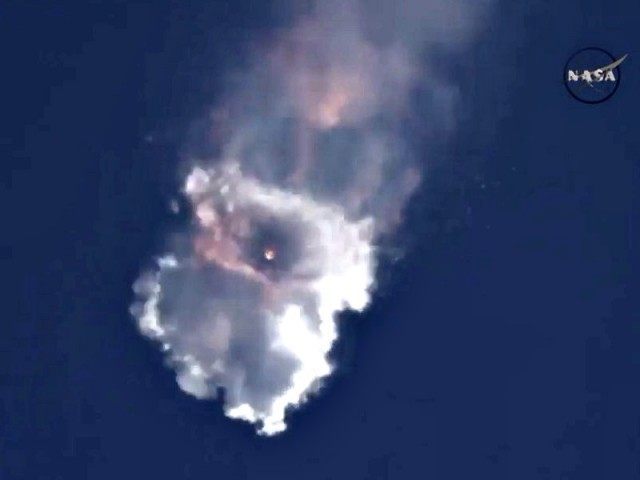An unmanned SpaceX Falcon 9 rocket traveling at 2,900 mph, about 27 miles above the earth disintegrated 2 minutes and 19 seconds into its flight from Cape Canaveral to the International Space Station.
It was a severe blow to NASA, still reeling from two previous failed Space Station resupply missions. The SpaceX failure is a reprieve for Russia’s Soyuz TMA-17M spacecraft that will remain the prime Space Station servicer, despite recently renewed US sanctions against Russia.
The SpaceX launch, its seventh robotic cargo mission to the International Space Station, was running at what NASA called “on course, on track” before the mission failure.
The liftoff was also expected to include a test of the SpaceX reusable-rocket technology that is attempting to bring the Falcon 9’s first stage booster down softly on an “autonomous spaceport drone ship” in the Atlantic Ocean. The company nearly succeeded in booster in recovery maneuvers on Dragon launches in January and April.
SpaceX CEO Elon Musk commented on Twitter that the cause of today’s failure during a first stage separation was “an overpressure event in the upper stage liquid oxygen tank”, which he said “suggests counterintuitive cause.”
SpaceX holds a $1.6 billion NASA contract to fly at least 12 unmanned resupply missions to the space station using the company’s Dragon capsule and Falcon 9 rocket. NASA’s mission control said that the failure is the second consecutive attempt to take a multi-filtration bed that purifies water on the Space Station. It appears doubtful that a new water unit can be built before the next NASA planned launch in August.
The Nasa mission was also carrying a first-of-its-kind docking port adapter, food, an extra space suit and lots of student research experiment for the International Space Station. NASA Administrator Charles Bolden said astronauts aboard the station do have enough water and supplies for several months, but he characterized the failed mission as a significant setback to the Space Station resupply program.
“We will work closely with SpaceX to understand what happened, fix the problem and return to flight,” Bolden said. “The commercial cargo program was designed to accommodate loss of cargo vehicles. We will continue operation of the station in a safe and effective way as we continue to use it as our test bed for preparing for longer duration missions farther into the solar system.”
It is unclear how long it will take for an investigative team to determine what went wrong with the SpaceX flight. Until the investigation is complete, SpaceX will not be eligible to fly missions to the Space Station.
The three current Space Station inhabitants include Commander Gennady Padalka and One-Year crew members Scott Kelly and Mikhail Kornienko. They are will be joined by veteran Russian cosmonaut Oleg Kononenko, rookie NASA astronaut Kjell Lindgren and first-time Japanese flight engineer Kimiya Yui when a scheduled Soyuz TMA-17M spacecraft lifts-off on July 22 from the Baikonur Cosmodrome in Kazakhstan.
Russian officials have moved up their next unmanned Progress cargo launch from Aug. 6 to July 3 in the wake of the non-explosive failure of their last resupply mission on April 28. An international investigative team said that a “design peculiarity” in the linkage between the Progress supply freighter and its Soyuz rocket, which was launched with an upgraded digital flight control suite and other modernizations caused the spacecraft to spin out of control after third stage separation. The July 3 launch will use an older version of the highly reliable Soyuz booster not susceptible to the problem that led to the loss of the Progress cargo capsule April 28.
Another manned liftoff for Russia’s Soyuz team is set for September 1. British soprano Sarah Brightman was slated to launch to the space station under a tourist contract with Space Adventures, accompanied by space station flight engineer Sergei Volkov and Danish astronaut Andreas Mogensen. But Brightman backed out of the mission in May.

COMMENTS
Please let us know if you're having issues with commenting.